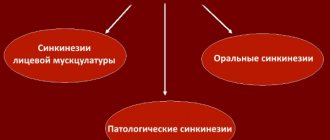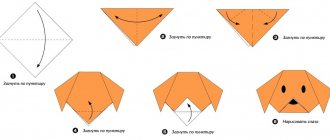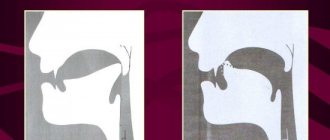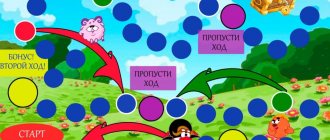How to develop speech up to 3 years. Expert advice
To form a speech, you should adhere to the following recommendations from experts:
- Play is very important for proper speech development. With its help, the baby learns about the world around him;
- must be read daily;
- you need to listen to the baby very carefully;
- It’s worth explaining your thoughts to the baby, reasoning with him, talking through plans for the future;
- the child needs to be asked questions that will encourage him to think;
- You need to discuss with your child how he spent his day in kindergarten;
- It’s worth practicing using images;
- The baby must always be supported, even if he doesn’t quite succeed.
Speech therapy chants for children 2-3 years old
Speech therapy for children aged 2-3 years is one of the main methods of working with children who have speech problems. During the work, exercises are used that were developed by Novikova-Ivantsova. Children more easily perceive phrases spoken in rhyme. Music has a beneficial effect on the psychological state of the baby. Together, this increases the effectiveness of the exercises.
The work is based on the ontogonistic principle. For those children whose vowel pronunciation is impaired, singing forms the correct acoustic image. The classes work on the ability to control the pitch of the voice. Children develop proper breathing when speaking.
Important! When selecting speech material for singing, it is necessary to take into account the age of the baby.
An example of speech therapy chants for 2-3 years:
- ku-ku-ku - the rooster crowed ku-ka-re-ku;
- gu-gu-gu - geese are wandering in the meadow.
Speech therapy chants
My previous post was dedicated to pure talk. If you have printed out the cards I posted or have worked with them before, you are probably convinced how much the kids like them. What if we add music to these funny rhymes? You will get speech therapy chants! And you and your baby will have even more fun!)
I learned about speech therapy chants when I saw in some VKontakte group a track list with funny songs that Ulyanka liked so much that I began to collect information about them.
My main find was T. Ovchinnikova’s book, which comes with a CD with 42 tracks.
It turned out that these songs can be, or rather should be, listened to not just like that, but according to a certain method, observing certain rules.
Firstly, they need to be listened to and taught in the order in which the sounds of the language are mastered: first, the pronunciation of vowel sounds is practiced, then syllables with “difficult” consonants (“s”, “z”, “l”, “r” and etc.)
Also, singing songs should be accompanied by certain exercises.
And there are a number of rules and very interesting points.
So, ideally, the child should sing only those sounds that are being worked on in this chant, the rest is sung by the adult.
Learning a song should be preceded by pronouncing the text, accompanying it with various rhythmic movements: clicks, claps, etc. That is, logorhythmics already begins here.
The child should not sit while singing; there must be movement.
It is useful to show vowel sounds with your hands and sing them with articulatory gestures.
Ovchinnikova also offers a very interesting exercise - “musical pencil”, that is, while listening to music, the child draws lines with a pencil, “noting” all changes in the melody. This, of course, is suitable for children of older preschool age.
For now, 2-year-old Ulyana and I are limited to listening, learning words and movements, singing, and my attempts to demonstrate vowel sounds with gestures.
In general, the main principle is that listening to music must be active.
I won’t go into more detail, as I will share the book and songs with you. In the book you will find detailed methodological instructions. Each song on the disc comes with notes and recommendations for exercises. Here is an example of 1 of the spreads
In addition, there are videos on the Internet with speech therapy chants. For example, like this
And there is also this little book.
You can buy it here. I couldn’t find it in electronic form. If anyone has it, please share!
And here is the promised download link
And here you can see the plan of posts on the speech development of the little ones!
If you found the material useful and are interested in me continuing to cover the topics of speech development in children, please like or comment on the post. This way I’ll know if I’m wasting my time)
Have a nice day, everyone!
Speech therapy exercises for children 2-3 years old
In the second or third year, you can do special speech therapy exercises with your child at home. They develop movements of the lips, tongue and lower jaw. They help strengthen the muscles of the articulatory organs, due to which the appearance of sounds occurs faster. All exercises are performed in front of a mirror.
You can do the following tasks at home:
- bursting of the bubble: the cheeks are inflated as much as possible. Press your palm first on one cheek and then on the other;
- wide smile: lips are drawn out, then you need to smile widely, showing your teeth;
- show your tongue: you need to quickly stick out your tongue and then remove it.
Speech therapy songs for children 2-3 years old
Speech therapy songs for children 2-3 years old are aimed at automating sounds and clarity of speech. The lyrics and notes of the songs interest children and create a joyful and favorable mood for them. The baby sings along with pleasure, and the activity takes on a cheerful and unobtrusive atmosphere. To conduct classes at home, just download online collections of songs from the Internet.
Innovative speech therapy technologies: syncwine
Games and tasks for speech therapists to develop higher mental functions
The child's psyche is not fully formed; the task of a speech therapist is to promote the all-round development of the child. Speech therapy songs for children, ditties and nursery rhymes, as well as various exercises - all this allows you to start the process of development and knowledge of the baby around the world.
Psychological work with a speech therapist
Card index of speech therapy games for preschoolers
Elimination of violations of written and oral speech occurs during gaming activities. You can make speech therapy cubes with your own hands or use ready-made ones in group games:
- Which sound? The teacher shows a picture, and the children name the sound made by an animal or a car, for example: Mu-u-u (cow) or tu-tu-tu (train).
- Read it quickly. All children love competitions, so the game “Who can read the word from the card the fastest” is fun and active.
- Ball game. The teacher throws the ball and names the word, and the child says the last sound in it: round dance - “d”, game - “a”.
Additional Information! In some cases, additional individual lessons with the baby are required if he has speech and hearing impairments.
How to conduct a speech therapy session at home for children 2-3 years old
At two or three years old, the baby cannot sit in one place for a long time. It is better to conduct classes with him only when the baby himself wants.
Important! First of all, it is necessary to establish emotional contact with the baby.
As home exercises for speech development, you can use finger games: you need to put your index finger and thumb together. Leave the remaining fingers straight. It is worth showing the children this cockerel and saying: “Peter the Cockerel, the golden comb, went to the market and bought a boot.”
Games for kids on onomatopoeia
To study sounds and syllables, you can use exercises to imitate the sounds of animals and objects. You can say the following words in a row with your baby:
- the pig repeats: “oink-oink, I’ll give you a liver”;
- a steam locomotive travels around the world and says: “too-too, I’m going”;
- the hare eats carrots with appetite and makes noise: “crunch-crunch”;
- the rain keeps repeating: “drip-drip, you need to take an umbrella with you.”
Developing hearing
Special games are used to train phonemic hearing. Examples of games:
- The child picks up two flags of different colors. For example, green and yellow. It is necessary to explain to the child that when a word is pronounced correctly, a green flag must be raised, and when a word is pronounced incorrectly, a red flag must be raised. For example: dog - tavern - lobaka, etc.;
- You can use pictures. The kid should clap his hands when he sees words in the picture that sound similar.
- Playing teacher. You need to read a fairy tale and intentionally make mistakes in it. The child must correct the adult.
Articulation gymnastics exercises for speech development in children 2-3 years old
During speech therapy classes at home, it is necessary to develop the muscles of the tongue. For this purpose, articulatory gymnastics is used. It is performed in front of a mirror. Exercises:
- the child imagines that the tongue is a brush. The mouth is slightly open. The tongue must be drawn across the palate towards the throat and back;
- mouth open wide. The tongue is located under the lower teeth. Raise the tip of the tongue under the upper teeth and lower it back;
- tongue cleans teeth. The mouth is wide open. First, the tongue passes over the lower teeth, and then over the upper teeth.
We teach you to pronounce hissing sounds using the methods of Fomicheva and Bogomolova
Replenishing vocabulary: learning poems and tongue twisters
Reading tongue twisters and poems helps to form beautiful and correct speech. They learn to pronounce letters without skipping or swallowing them.
Important! Particular attention should be paid to tongue twisters starting with the letter “P” and hissing ones.
Tongue Twisters:
- Grass in the yard, firewood on the grass.
- Karl stole corals from Clara, Clara stole a clarinet from Karl.
Conducting and organizing speech therapy quizzes for preschoolers
All participants are divided into several groups. Each team prepares its own motto and uniform.
Quiz progress:
- The teacher reads out a greeting and offers tasks that the children must complete.
- A mini-scene from the book is played out.
- Physical warm-up by humming a children's song.
Parents can be involved in the quiz. Together with their children, they repeat tongue twisters and nursery rhymes.
Art therapy in speech therapy
Art therapy is used in correctional work; drawing in speech therapy is one of the ways to quickly correct a difficult situation.
Types of art therapy:
- modeling;
- drawing;
- music therapy;
- choreography;
- photographing;
- sand therapy.
Creative activity is not similar to ordinary group classes; the child relaxes and allows the speech pathologist to carry out correctional work.
If there are serious speech impairments, then it is advisable to use a combination of methods: vocals, art therapy, drawing, participation in theatrical productions. An active child undergoes correction faster and begins to speak correctly.
The first session of a speech therapist with a child: where to start
Speech therapy classes are carried out for the following purposes:
- Understanding native speech, observing and comprehending everything that happens around. This is how the child learns about the world around him. The speech therapist forms general concepts, gives the basics of word formation, and teaches how to use complex phrases.
- Formation of correct pronunciation of words and development of phonemic hearing. Monitoring the clarity and expressiveness of speech.
- Teaching independent speech using different sentences.
Many people are interested in how the first speech therapist session is conducted. The first session of a speech therapist with a child, where to start:
- The child's disposition towards himself.
- Carrying out diagnostics and identifying problems.
- Introduction to the speech apparatus.
- Teaching simple speech therapy exercises and games.
- Building a work plan.
Literature to help the speech therapist: Fadeeva Yu. A., Pichugina G. A., “Speech therapy classes in the younger group”
The abstract by Fadeeva and Pichugina is intended for speech therapy classes in the younger group. It promotes the formation of speech skills in children two to three years old who have various speech problems of different etiologies. It is intended for speech therapists, speech pathologists, educators and parents.
Stages of working on a new word in speech therapy
Stages of working on a new word in speech therapy:
- Determining the relationship between a sound word and a visual, auditory and other image.
- Analysis of word composition.
- Identification of semantic features of a word.
- Introduction of a word into the semantic field.
- Consolidating the meaning of a word.
Using speech therapy cubes for speech development
Speech therapy interactive games for the development of preschoolers and blocks are used in the junior and preparatory groups. With their help, children perform different tasks:
- Collect a word from the syllables and pronounce it.
- Repeat the syllables from the cubes that the teacher shows.
- Build a tower to form a word.
Important! During the lesson, you need to maintain the element of play and the child’s interest in what is happening. In the process, they become involved in the lesson and complete all tasks, correcting their speech.







